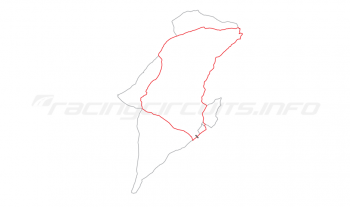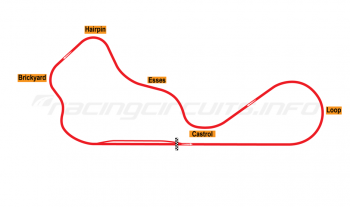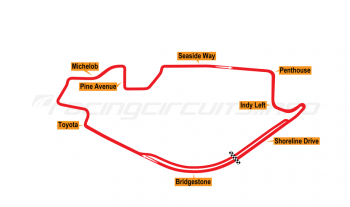Preluk - Opatija
Circuit Overview
The Preluk street circuit at Opatija on the Adriatic Coast has the distinction of having been located in three separate countries during its lifetime, as much like its modern successor at Rijeka, geopolitical changes have played their part in its history. Now in Croatia, it has variously been in Italy and then, post-World War II, part of the former Yugoslavia.
A hugely challenging and picturesque course which hugs the hillside above the coast, racing has been a part of the Kvarner area since the 1930s. The course offers a huge challenge whether on two wheels or four, with 85 metres of elevation change across its 6km run, weaving between houses, coastal walls with sheer drops below and unyielding rock faces. Add in long fast straights and it's not hard to see how it won its fearsome - and all too often deadly - reputation.
It was the latter which proved its downfall and prompted a ban on racing by the FIM after a disastrous race in 1977, prompting the local authorities to build the permanent circuit at Rijeka.
Circuit History
Local car races are recorded as being held on the course as far back as 1931 but it wasn't until 1939 when it achieved international prominence - almost by accident. The Adriatic Grand Prix likely would have attracted a relatively small field of racers from around the region until national politics came to play. The Italian dictator Benito Mussolini had forbidden the Maserati works team of taking part in the French Grand Prix at Rheims, so instead the team organised a consolation trip up the coast to Abbazia (as Opatija was then named).
The works team comprised two Maserati 4CL's for Gigi Villoresi and Franco Cortese and the 24 valve Maserati 6CM for Giovanni Rocco. Six other 6CMs were also on the grid. At the start Rocco's 6CM led Villoresi and Cortese but then fell back with engine problems, allowing Villoresi and Cortese to complete the 93 mile-race in an easy demonstration. For Villoresi it was a bittersweet victory, coming as it did just over a fortnight after his brother Emilio had been killed testing an Alfa Romeo at Monza.
Bikes races are introduced
Further opportunities to build on this international interest would be abruptly halted with the outbreak of World War II and it wasn't until 1946 that racing would resume - this time for competitors on two wheels. Local races were held that year, with little known about the winners save for them being from Zagreb. The following year the races counted as part of the first Yugoslavian national championships. Ivan Vukelić won both the 1000cc and 500cc classes, while there were also races for 350cc, 250cc, 125cc and sidecars.
Initially the bike events were run under the Prix de l'Adriatique banner, before adopting the more fashionable Grand Prix moniker from 1960, while the following year the 50cc race formed the fifth round of the FIM European Championships, won by German rider Hans-Georg Anscheidt on a Kriedler.
By 1950 car racing also resumed as the emergence of sportscar racing - often fuelled by wealthy amatuer owners - meant the chance to race in the resort town became irresistible. The circuit hosted GT and sportscars throughout the 1950s, with Franco Cortese returning to win with a Ferrari in 1956.
Organisers switched the main race to Formula Junior single seaters in 1960, with Kurt Ahrens the most notable victor before a change again to the emerging Formula 3 category in 1964. The 1966 race almost didn't happen; heavy rains reduced the track to little more than a skating rink and the organisers wanted to cancel it altogether. A poll of the drivers produced deadlock, with as many wanting to race as sit it out. In the end a compromise was struck, with the race reduced from 12 laps to just five and, even then, there were many spins among the pack before Frenchman Patrick Dal Bo slithered to victory.
Car racing judges the course too dangerous
By the end of the decade, the circuit was coming under greater scrutiny from a safety perspective and car racing soon become untenable, with the last event being held in 1968. Bike racers seemed less concerned by the obvious dangers - or at least those organising the races took a more liberal view of safety. Indeed, in 1969 the Adriatic Grand Prix became a round of the FIM Motorcycle World Championships, launching a golden era in the circuit's history. Godfrey Nash rode a Norton Manx to victory in what was the last victory for a single-cylinder machine in a 500cc Grand Prix.
Riders the calibre of Giacomo Agostini, Chas Mortimer and Angel Nieto all tasted success at Preluk, though the track had a similar reputation as the Isle of Man TT Course and was not universally popular with riders who generally felt it to be too dangerous. Things boiled over in 1973 when the race came immediately after fatalities at Monza and the Isle of Man TT and the Yamaha, Harley and MV Agusta teams all elected to boycott the race as they considered it too dangerous.
Just a year later the dangers became all too evident when British rider Billie Nelson crashed into the crowd during the 250cc race, injuring several spectators, two of them gravely. Nelson also suffered fearsome injuries and died the same night in hospital. Perhaps surprisingly given the inherent dangers, his was the first rider death since 1951, when Josip Vitanovic was killed.
The final hour arrives in tragic circumstances
Sadly, worse was to come in 1977, in what was to become a very dark event for motorcycling and the final straw for the Preluk circuit. In the run up to the event there were heavy rumours that it would be cancelled after the FIM issued an ultimatum to the organisers that if they did not improve safety at the circuit, the race would be dropped. Tragically, it was allowed to go ahead.
Things began badly when, during practice for the 250cc race, Giovanni Ziggiotto crashed when his Harley Davidson's engine seized. He was hit by Per-Edvard Carlsson, who had been following directly behind, and died four days later in hospital. Then, in the 50cc race, Ulrich Graf crashed after his Kreidler suffered a rear tire failure while travelling at a speed of about 130 km/h. He was sent into the rockface at the edge of the track and died shortly afterwards in a local hospital. In total, another 19 riders were injured during the course of the disastrous weekend.
Recrimination came swiftly and the FIM banned all road races from the World Championship Calendar. Preluk's racing days were over and - in double quick time - a modern replacement circuit was constructed at Rijeka, a few miles up the road.
Jump onboard
Circuit info
This is a historic circuit which is no longer in operation.
Rate This Circuit
Votes: 4394
Location Information
The Preluk circuit is located next to the sea on the road between the village of Opatija and the city of Rijeka in Croatia. Today there is very little to suggest that there was ever motor racing held here, though all the roads are intact. Perhaps this shouldn't be a surprise given the extremely rudimentary safety facilities in place when it was used for racing - little more than the occassional straw bale...
The roads do still occassionally see some action as special stage during Croatian Rallies national rallies (with some chicanes added) and for historical parades.
Overall, it's in a delightful spot just around the coast from Opatija itself and there is a small karting centre next to what was once the paddock area. It's worth a brief diversion if you find yourself heading towards Autodrom Grobnik further along the motorway.
Get your race tickets!
Brought to you with: 
We've teamed up with Motorsports Tickets to bring you the best deals for Formula One, MotoGP, Le Mans and more.









